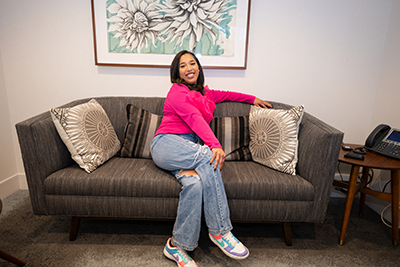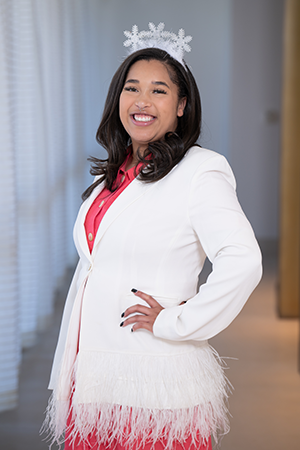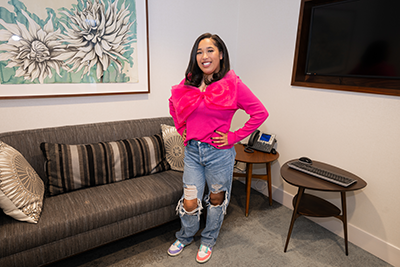
Meet Sydney: A novel double organ transplant offered her a pathway to achieve her dreams
Sydney is living her dream life thanks to her care team at Children's Health℠.
After several outfit changes, Sydney landed on a green dress with puffy sleeves that faintly showed the incision down her chest.
She sat in a director’s chair as a make-up artist brushed bronzer on her cheeks. Quietly, she rehearsed her monologue. The script called for saying the lines while on the move to her set (even sometimes while walking backward!). She had a knack for public speaking, but still, as a junior in college, the experience under the hot lights was new.
As a kid, Sydney hosted a YouTube channel called “The Sydney Show,” that was filmed at home by her mom. She taught friends and family about the importance of relaxing with yoga and featured a healthy eating segment that involved cooking ramen. (She now laughs at the irony of “healthy” cooking.)
But this moment — with her name in bright lights and multiple cameras capturing the angles of her face — felt like a dream.
Because after a double organ transplant two years earlier at Children’s Health that saved her life, it was her dream. Almost a decade after launching “The Sydney Show” as a kid, her talk show got a one-time reboot, when she invited her family and members of her care team back to recount her journey.
She took a deep breath as the cameras began to roll. And with energy that she seemed to bottle until the producer yelled action, she leapt from the chair. This was the wish she’d had all along — her moment to shine.
A new heart journey with the help of innovative technology
Sydney was a freshman in college and exploring her mass communications major when she became too sick to stay at school. “I’ve known for my entire life that eventually I might need a heart transplant and maybe a liver transplant. I was ready,” Sydney said.
Her team of doctors was ready, too. Leading her care team was Ryan Butts, M.D., Medical Director of the Pediatric Advanced Cardiac Care Program at Children’s Health and Associate Professor at UT Southwestern.
Sydney was one of the first pediatric patients in the country to receive a heart and liver transplant with the help of an innovative technology called normothermic machine perfusion. The technology helps keep donated organs as healthy as possible before and during transplant, leading to more effective procedures and better outcomes for patients like Sydney.

“Our community needs resources like Children’s Health because there are a lot of kids that are sick and need specialized care,” Sydney said. “Children’s Health does a great job at catering to kids who need help — they did everything to put my health first.”
Sydney's cardiac care began with a sonogram
When Sydney's mom Chelle was pregnant, she got some special treatment from her OB/GYN. That's because the clinic she went to was also where Sydney's dad, Marc, practiced. One day the sonogram nurse noticed an abnormality with baby Sydney’s heart. Soon, Chelle and Marc learned their baby had hypoplastic left heart syndrome (HLHS), which happens when the left side of the heart doesn't fully develop.
She had her first surgery at a few days old, and they had to leave her chest open. I could actually see her heart pumping. The first time I held her was intimidating. There were so many tubes and machines connected to her little body. But something about this baby was so peaceful. I knew she was going to make it.
— Chelle
Sydney had two more open heart surgeries before her fourth birthday. Because of her condition, she couldn’t do sports, so she danced. After graduating with the class of 2022, Sydney was off to Southern University. College was everything she hoped for. But during her second semester, she realized that even a walk between classes left her feeling exhausted. Then, she started feeling severe pain in her stomach.
"One day, Sydney called and said, ‘Mom, I need to come home.' This was a girl who would push through anything, and the worst thing she could imagine was leaving school," Chelle said. "When I went to get her from the airport, she collapsed in my arms crying. I knew her next heart journey was beginning."
Planning and preparing for a complex procedure
Sydney and her parents met with a team of The Heart Center and Pediatric Liver Transplant Program doctors who began to unpack everything about Sydney's health and make a plan to restore it. This meant Sydney would need an expert care team who could carry out not one but two transplants.

At the ready were Dr. Hwang and Ryan Davies, M.D., Pediatric Cardiothoracic Surgeon at Children's Health and Professor at UT Southwestern.
"People born with HLHS often eventually need a heart transplant, and some need a new liver. That's because, even after the surgeries she had when she was little, Sydney's heart wasn't able to bring blood from the liver to the heart as efficiently as it's supposed to," Dr. Hwang said.
Together, the family and providers decided that Sydney would move forward with the transplant process, and Dr. Butts began walking them through every aspect of the plan, including the challenges of finding a match.
"Dr. Butts reminds me a lot of my dad," Sydney said. "He broke down the medical information so I could understand what was happening. He was the person I could go to for anything."
Dr. Butts was especially impressed with Sydney's commitment to her physical health. He explains that while he was looking at her labs and making adjustments to her medications, Sydney had to work, too.
"This surgery takes a huge toll on your body, and the more nutritional reserves a patient has, the better they'll heal. Our patients work closely with a dietitian, and they need to stay moving. Sydney did a great job as my partner in maintaining her health," Dr. Butts said.
For Sydney's family, her transplant marked what they hope will be the end of a lifetime of uncertainty fought off by their deep faith and confidence in her care team.
"As a mom, every part of this process is daunting. There were times where I was completely overwhelmed by the hope of the best-case scenario and the realities of the worst," Chelle said. "But I've been watching this girl endure the health challenges that she's been dealt since before she was born."
Moving into Children's Health – Sydney's wait begins
On July 5, 2023, Sydney officially moved into Children's Health to be ready for donor organs as soon as they were available.
While waiting for two new organs, Sydney worked her way through a stack of books. She taught herself how to crochet. She played card games with her nurses. And when she needed a boost, she leaned on her faith.
Finally, at the end of July, the day had come – two organs were available, and they were for her. "My whole family was with me before my surgery. We prayed together, we took pictures and then a few hours later I woke up, and I knew it didn't happen," Sydney said.

A couple of hours into the surgery, while Dr. Davies was preparing to take Sydney's heart out, the donor heart stopped working. The family was disappointed but not discouraged. Sydney was determined. She had made it through three major heart surgeries before preschool. She would not give up now.
Almost a month later, another set of organs was ready for Sydney.
A new technology offers a win-win for patients and providers – less waiting and healthier organs
With the second set of donor organs, Sydney’s doctors had the opportunity to utilize an innovative piece of technology. They wanted to keep the donated organs as healthy as possible before and during the surgery, ensuring the most effective procedure and the best outcome for Sydney.
Children’s Health is hyper-focused on making innovations that minimize the time a patient waits for an organ and optimize the health of the organ they receive. One of the tools that can help us succeed is NMP. Sydney is helping us show the rest of the pediatric transplant community what is possible.
— Dr. Davies
"Every minute an organ spends not working in a body, its cells start to break down. An organ sitting on ice is only viable after about 4 to 6 hours," Dr. Davies said. "NMP keeps warm oxygen-rich blood pumping through it, mimicking the body's natural conditions."
The machine minimizes the shock an organ experiences being moved from one body to another and can double or triple the duration of the organ's viability. This was especially important for her new liver, in case there were any challenges with the heart transplant.
In the operating room, Dr. Davies was glad to see Sydney’s new heart was doing well with the support of the pump. “The technology provided a lot more information about the heart’s health as I was operating. It also meant that I had a better understanding of how the heart was going to do when I passed her to the liver team,” Dr. Davies said.
After 88 days in the hospital and surgery that started on a Sunday and ended on Monday, Sydney finally had a healthy heart and liver. "It was probably a week before she was awake enough to realize it happened, so I sat with her and held her hand and waited for her to squeeze my hand," Chelle said.
For Sydney, the most difficult part of the experience was the recovery. She spent the first couple of weeks with bandages wrapped around her body, making it difficult for her to move. Her throat burned for days after the ventilator was removed. Sometimes, the nerve pain felt unbearable. When she was finally able to stand, walking became another hurdle she wasn't expecting. "My rehab team and the nurses kept telling me I had to give myself grace. At first, it was hard to celebrate my progress, because walking should be easy," Sydney said.
Improving pediatric transplant medicine and a reboot of “The Sydney Show”
A couple years after her transplants, Sydney has noticed a huge difference in how she feels
and how much energy she has. Last year, she returned to college in-person and continues to pursue her major in communications.
And her journey is paving the way to improve pediatric transplant medicine, including the time patients wait for organs. Her clinical team recently published a research article documenting Sydney’s procedure using the innovative pump and long-term health success so other hospitals can learn as they care for future pediatric transplant patients.
“Everyone at Children’s Health wants to take on the greatest challenges in transplant medicine. Sydney’s success will be studied by physicians around the world. With this new pump, we have the opportunity to qualify more organs and take on more complex cases. That means a lot as a physician, but it means even more to the families whose kids are very sick,” Dr. Davies said.
Philanthropic donations play a key role in pioneering research and breakthroughs in pediatric cancer, heart and liver disease for patients like Sydney. Generous gifts also allow Children’s Health to expand its facilities to treat more kids closer to home, especially as we build the new Dallas pediatric campus alongside our colleagues at UT Southwestern.
“We provide care that no other hospital in the region can,” Dr. Davies said. “It’s really important to have a bigger hospital to be able to take care of kids — more kids — and do more things for all of those kids.” And that includes making their biggest dreams happen every day.
Philanthropic support helps make the impossible possible for kids and young adults. For Sydney, that means a reboot of her childhood talk show, “The Sydney Show,” where she invited key members of her care team such as Drs. Butts and Davies as guests.
They sat on comfy couches and chairs under hot lights as Sydney asked them to recall some of the biggest moments in her journey. And when the interview wrapped, they gave each other high fives.
“We did it!” Sydney cheered.
Meet more Children's Health patients
Read more patient stories like Sydney's and meet our Patient Ambassadors to learn how Children's Health makes life better for children.
How you can help
Help kids like Sydney by exploring our ways to give or by giving today!
Kids count on us. We count on you.
Give to support innovative research, lifesaving treatments and compassionate care.
Did you enjoy this story?
If you would like to receive an email when new stories like this one are posted to our website, please complete the form below. We won't share your information, and you can unsubscribe any time.

